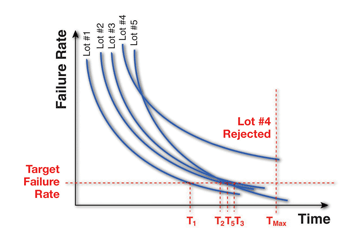Hi-Rel COTS devices combine reliability and performance in the latest in capacitor technology
BY CHARLES POTHIERVishay IntertechnologyMalvern, PAhttp://www.vishay.com
When it comes to solid tantalum capacitors, a gap exists between what is available commercially and what is available in MIL specifications. Because the commercial industry drives new capacitor technology development, military-qualified capacitor offerings have not kept pace with technology advancements.
Defense electronics designers require the latest in technology, but lacking the availability of MIL-specified capacitors, they will often select standard commercial products without screening. Unfortunately, these capacitors are not intended for high-reliability military applications, and may lead to reliability issues.
Available solutions
Historically, there have been few solutions to help bridge this gap. These include customer-developed source control drawings, where the customer provides the specifications to screen the capacitors, and Defense Supply Center Columbus (DSCC) drawings. Until recently, the industry as a whole has not done a good job of making customers aware of the need for screening commercial capacitors.
Also, customers were forced to seek out solutions from manufacturers. Therefore these solutions lack consistency between specifications, as they are available by customer request on a case-by-case basis. In addition, they are often developed as a solution to an existing reliability problem, and implementing them could involve a costly retrofit.
To bridge the gap, manufacturers now offer and promote high-reliability (Hi-Rel) commercial-off-the-shelf (COTS) tantalum capacitors. These products combine the reliability required in demanding military applications with the latest in capacitor technology required to meet challenging design goals.
Hi-Rel / COTS devices
Hi-Rel / COTS devices overcome the limitations of previous solutions by increasing consistency. They are also proactively promoted throughout the industry, so there is increased awareness of the solution in the OEM community. The right solution designed in up front eliminates the need to search out a solution to an existing problem.

A Weibull distribution plots a device’s failure rate vs. time. This plot is for tantalum capacitors.
As reliability is more affected by design than by screening after the fact, Hi-Rel COTS capacitors should start with the most robust commercial designs and be redesigned for improved reliability where necessary. Every capacitor should meet Hi-Rel qualifications, which go beyond standard commercial-grade qualifications.
Devices should be held against standards that are in accordance with the Group-A inspection requirements of MIL-PR F-55365, including reflow conditioning, thermal shock, surge current, and reliability screening. These devices should also meet internal qualification requirements and be subject to an ongoing comprehensive reliability-monitoring program.
COTS screening processes
COTS solutions can be tailored to meet the needs of a specific application. There are two types of screening: surge-current processing and reliability screening.
Surge-current processing options include a commercial standard (3 cycles at 25°C), military standard (10 cycles at 25°C), and space standard (10 cycles at –55° to 85°C). Reliability screening options include 40-hour voltage aging at rated voltage, 85°C, and Weibull failure-rate grading, where an accelerated voltage is used in order to predict long-term performance.
Reliability screening in the form of voltage aging (or burn-in) involves subjecting all parts to rigorous test conditions that are intended to accelerate the aging process, thereby weeding out any potential weak devices that would lead to infant-mortality failures. By combining high temperature and high voltage as acceleration factors, voltage aging helps ensure that only the best devices reach the customer.
Weibull grading
Weibull failure-rate grading is an improvement on the simple burn-in technique. This technique uses a mathematical model describing failure rate vs. time for tantalum capacitors to predict long-term reliability of tested parts based on their failure rates during test.
Using accelerated voltages 1.3 to 1.5 times the rated voltage, and 85C as an accelerated temperature, this technique grades the failure rate for lots under test. This approach has several advantages over a simple burn-in:
Since test time is variable (testing continues until the failure rate converges at the desired level or testing is aborted), this approach will eliminate lot-to-lot variations naturally occurring in production.A failure rate is established for the lot based upon its use at rated voltage and 85°C. Use at derated voltages and temperatures further improves predicted failure rate.This approach helps identify whole lots that exhibit atypical reliability performance, which are rejected since they would fail to converge on the desired failure rate.
Surge-current testing
Another important form of screening, surge-current testing, is directly targeted at screening out tantalum capacitors that have an overabundance of imperfections in the dielectric. Such imperfections can be the starting point for a dielectric breakdown of the capacitor when under electrical stress.
This screening method uses a large capacitance bank to deliver copious amounts of current at rated voltage to parts under test. Using no current-limiting resistance (other than cable resistance of less than 0.5 Ω), this capacitor bank is charged to rated voltage, then switched onto the parts under test. This sudden surge of current will cause heating at the leakage sites within the dielectric.
This heating results in a chemical change that converts the cathode material from a conductor to an insulator, effectively “healing” the leakage site and shutting down the flow of current. If the leakage site is too large, the stress will push the capacitor into dielectric breakdown and it will be identified and removed from the lot under test. In its simplest form, this test either heals the capacitors or destroys them.
For today’s design engineer surge current testing is helpful to avoid failures on turn on. It is also highly recommended if the end application involves an ac or pulsed signal with an appreciable current. ■
Advertisement
Learn more about Vishay Intertechnology





